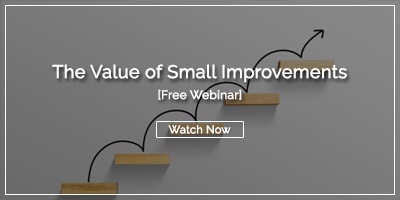 John Shook, Senior Advisor of the Lean Enterprise Institute, is among those who describe Lean or the Toyota Production System as being neither top-down management nor bottom-up management. It's not about the boss telling people what to do, and it's not a system where employees are empowered to do whatever they want. Instead, an effective culture and management system has top-down AND bottom-up communication, decisions, and improvement elements. Ideally, leaders will communicate the big picture and the "why" of improvement, while those lower in the organization tend to figure out "what" and "how" to improve.
John Shook, Senior Advisor of the Lean Enterprise Institute, is among those who describe Lean or the Toyota Production System as being neither top-down management nor bottom-up management. It's not about the boss telling people what to do, and it's not a system where employees are empowered to do whatever they want. Instead, an effective culture and management system has top-down AND bottom-up communication, decisions, and improvement elements. Ideally, leaders will communicate the big picture and the "why" of improvement, while those lower in the organization tend to figure out "what" and "how" to improve.
Top-Down Management
The top-down approach to management is the traditional way that businesses are run. Most people are familiar with this management style in which a boss tells them what to do, and they do it. When something is changed, it is usually initiated by leaders and carried out by employees.
In this management paradigm, executives and upper-level leadership make all the decisions, set the strategy, and coordinate implementation. These top leaders direct the course of the organization. They then cascade those decisions down the hierarchy of middle-level management to lower-level supervisors and finally down to the front-line employees carrying out the tasks.
Pros
- Most people are familiar and comfortable with this type of management
- Tight control allows for strategic alignment across goals, improvement projects, and daily tasks
- Expectations are clear for the entire organization
- Front-line employees focus on their core responsibilities
Cons
- Employees can become disconnected from the company's purpose and values
- The success of the organization relies on the decision making of a few people
- The approach does encourage as much innovation or diversity of ideas
Bottom-Up Management
By contrast, the bottom-up management style is a grassroots style of management. Team members are empowered to suggest ideas that might change how the company operates. While leadership maintains responsibility for the strategic plan, lower-level managers and employees contribute to its development and deployment.
Pros
- Employees are more engaged with the company culture, purpose, and goals
- A sense of ownership improves performance and productivity
- Employees can set objectives that are tied to their strengths
- Employees have insights into the day-to-day processes and problems that leaders might not see
Cons
- Too much input can create disorganization, disagreements, and slow forward progress
- Employees might feel uncomfortable sharing ideas and candid feedback with managers and leaders
- Employees may undertake improvement projects that aren't related to the most critical strategic goals or annual objectives
A mixed management approach is ideal for minimizing the cons and taking advantage of the pros.
It is helpful to understand what top-down and bottom-up management looks like and how they are critical to a culture of continuous improvement.
Who Initiates Improvement
The first difference between top-down and bottom-up management lies in who initiates the improvement efforts. From the top, senior leaders identify vital organizational goals and strategic objectives. They then engage staff as necessary to achieve those company goals through improvement projects, kaizen events, or other tactics. For example, the VP of Quality may decide that a Gemba walk is in order to figure out the cause of product defects. Her goal is to improve quality by visiting the factory flower. This goal is achieved by engaging others directly involved in the production process.
On the other hand, Bottom-up improvements begin with front-line staff, process operators, and managers. These team members notice opportunities for improvement in their daily work. For example, they find a way to make their job more enjoyable, their work more efficient, or to provide a better service to customers. When implemented, these ideas contribute to the organization's overall health, even though they were not identified as part of a larger, top-down initiative.
Regardless of who begins the process of positive change, the effort is collaborative. In the best case, every employee understands how they contribute to the critical goals and can align improvement with the strategy no matter where they sit on the org chart.
Who Participates in Improvement
Because top-down improvement typically comes in the form of projects or events, the number of participants is usually small. For example, a leader may assemble a team of two managers and five front-line employees from different areas to conduct a value stream mapping event.
The goal of bottom-up improvement is to include every person at every level of the organization in continuous incremental change. Each employee looks for ways to improve their work daily, regardless of their location, shift, and function, resulting in a culture of continuous improvement.
Improvement management software helps keep track of both projects initiated by leaders and daily improvement efforts at the front-line level.
The Frequency of Improvements
While top-down improvement takes place in scheduled, episodic activities and time-consuming management cycles - like a weeklong event - bottom-up improvement happens all day, every day. Do you see an opportunity for improvement on your way to lunch? Log that. See a safety concern as you walk out the door? Log that too. When employees get good at seeing problems or identifying waste, they'll see it every day, even after a lot of improvement has already taken place.
Organizations that don't support and value bottom-up improvement miss out on the chance to benefit from incremental improvement. The employees who are closest to the production process and customers are in the best position to engage in problem-solving and can do so at a much quicker pace than executive leadership.
Scope of Projects
Is it a top-down or bottom-up improvement that takes on significant challenges? When there is a big problem that requires a major overhaul, top-down management is the most common approach. These projects are typically higher cost and higher risk, so there's a lot of research and planning that goes into them ahead of time. Even if management decides "what" needs to be improved, employees and managers will need to be involved in figuring out the details of the "what" and the "how." Leaders shouldn't give employees all of the answers. But they can set direction, inspire people to participate in driving these major changes, and provide coaching along the way.
On the other hand, bottom-up improvements are typically small, low-cost, low-risk changes that front-line staff are able to implement on their own or within their team. The role of leaders here is to provide the assistance necessary to make sure that people stay on the right track, but they don't really need to get over-involved in the process.
Tracking Improvement Results
Regardless of whether an improvement was started at the top or bottom of the org chart, tracking improvement results is essential so that everyone can gain insight into the results of the effort. Leaders should have a dashboard that visualizes the activities, engagement, and impact of improvement work by location, team, individual departments, or functional areas.
Every employee should be able to search for related past improvements to build on lessons learned and past disappointments. In addition, it is a best practice to broadcast improvements to help spread enthusiasm for positive change.![[Watch Now] Bottom-Up Improvement](https://no-cache.hubspot.com/cta/default/326641/804fb6fa-7d09-4472-9c33-824363af1f8a.png)
By embracing both management styles, organizations can make the most of the potential of each member of the team. Change can be controlled yet frequent and meaningful. Employee engagement, along with strong leadership, form the bedrock of success.
-01.png?width=1000&name=Kainexus%20Infographic%20-%20July%202022%20(2)-01.png)
![[Watch Now] Top-Down Improvement Software Demo](https://no-cache.hubspot.com/cta/default/326641/2eef07b8-9131-49c5-9adc-bafb52e8796e.png)


Add a Comment